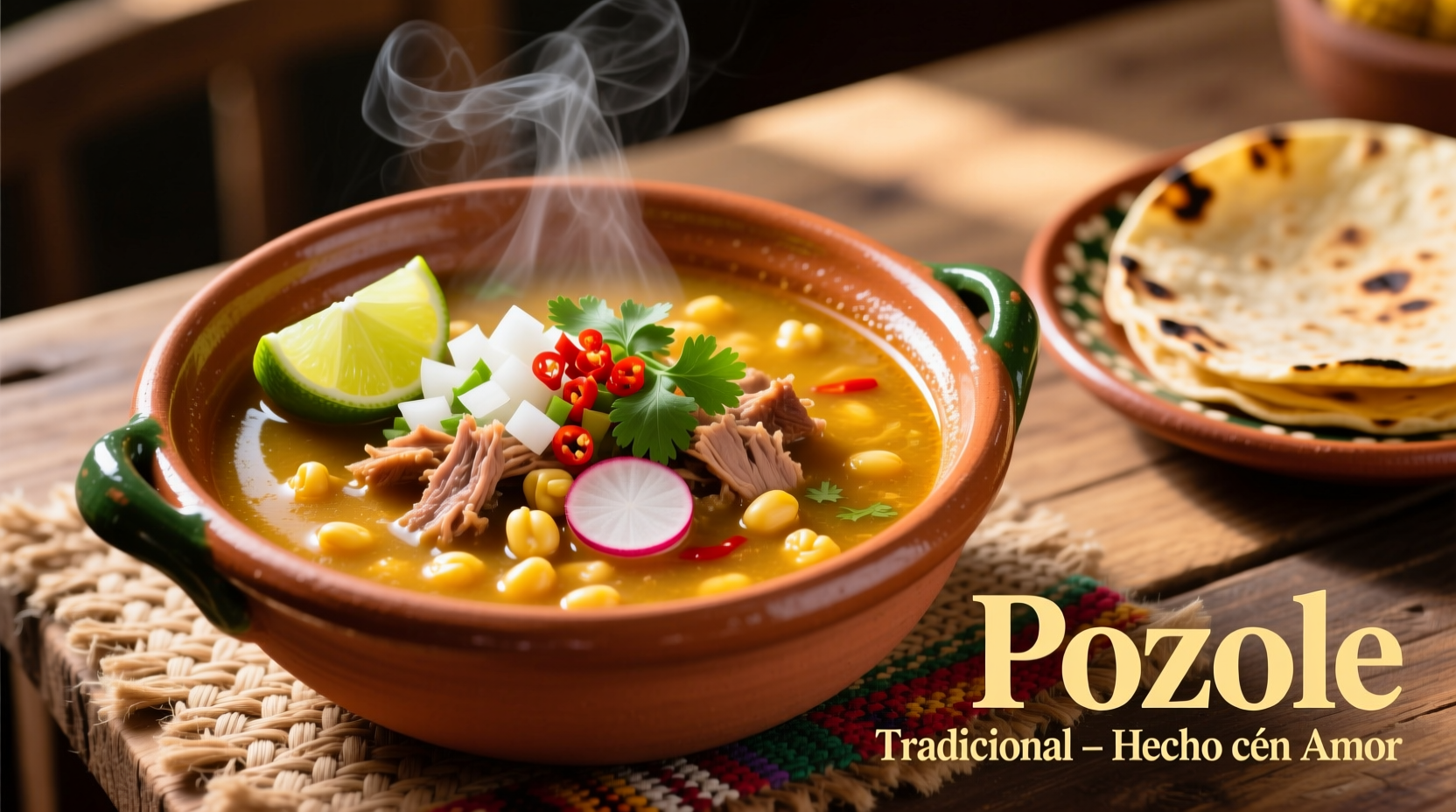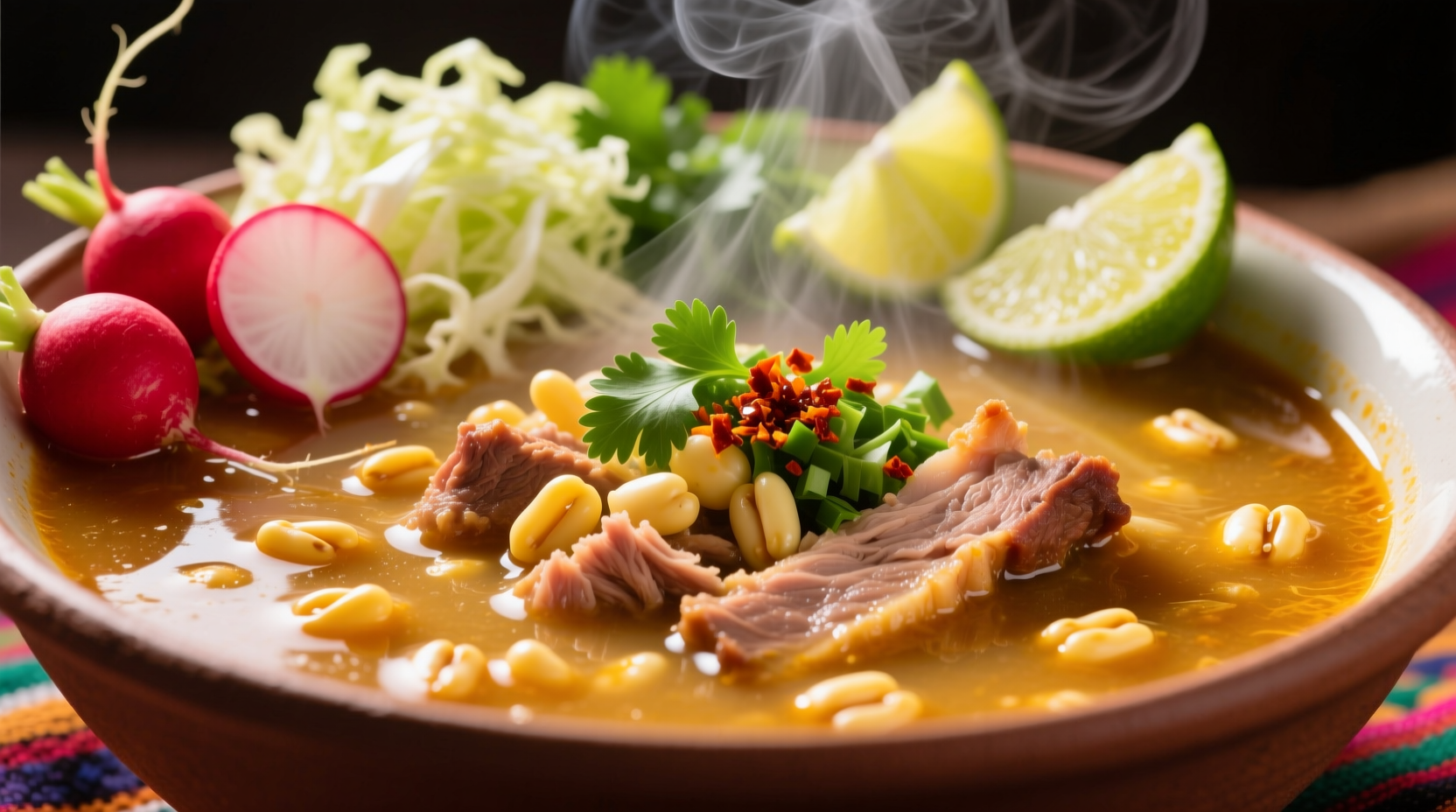If you've ever wondered what makes pozole stand out among Mexican comfort foods, you're about to discover why this ancient dish has captivated palates for centuries. As someone who's documented indigenous spice traditions across Latin America, I can tell you pozole's magic lies in its perfect balance of simple ingredients transformed through careful preparation.
The Core Flavor Profile: What Makes Pozole Unique
At its heart, pozole delivers a satisfying interplay of flavors and textures that define Mexican culinary tradition. The foundation comes from hominy (nixtamalized corn), which contributes a distinctive chewy texture and subtle earthy sweetness that's completely different from regular corn. When properly prepared, hominy absorbs surrounding flavors while maintaining its own character.
The meat component—typically pork shoulder or chicken—simmered for hours creates a rich, savory broth that forms pozole's backbone. What elevates this simple stew into something extraordinary are the carefully balanced seasonings:
- Dried chilies (guajillo, ancho, or mulato in red versions) provide deep, complex warmth without overwhelming heat
- Garlic and onion build aromatic foundation notes
- Oregano (Mexican variety) adds earthy complexity
- Cumin contributes subtle warmth in some regional variations
Regional Variations: How Pozole Tastes Across Mexico
Understanding what pozole tastes like requires recognizing its three primary regional expressions. Each version tells a story of local ingredients and culinary traditions that have evolved over centuries.
| Variety | Key Ingredients | Flavor Profile | Primary Regions |
|---|---|---|---|
| Pozole Rojo | Dried red chilies, garlic, pork | Rich, deep chili flavor with subtle smokiness and moderate heat | Jalisco, Michoacán, Guerrero |
| Pozole Verde | Tomatillos, pumpkin seeds, epazote, green chilies | Bright, herbal, slightly tangy with fresh green chili notes | Guerrero, State of Mexico, Morelos |
| Pozole Blanco | Simple broth, minimal seasoning | Clean, meat-forward with subtle corn sweetness | Nayarit, Sinaloa |
Texture: The Often Overlooked Element of Pozole's Taste Experience
What does pozole taste like? The answer isn't just about flavor—it's equally about texture. Properly prepared hominy provides a unique chewiness that's both substantial and delicate. The kernels should be plump and tender but maintain their shape after hours of simmering. This textural contrast against the tender meat and smooth broth creates a satisfying mouthfeel that defines authentic pozole.
Many first-time pozole eaters don't realize how much garnishes transform the experience. Traditional toppings aren't mere decoration—they're essential flavor components that let you customize each spoonful:
- Shredded cabbage or lettuce adds refreshing crunch that cuts through richness
- Lime wedges provide bright acidity that lifts the entire dish
- Oregano (Mexican variety) adds earthy complexity when sprinkled fresh
- Chopped onions contribute sharp sweetness
- Chili powder or sliced jalapeños for those who prefer extra heat
Historical Context: How Pozole's Flavor Evolved
Pozole's distinctive taste profile developed through centuries of culinary evolution. Archaeological evidence from the National Institute of Anthropology and History in Mexico shows that nixtamalized corn dishes similar to pozole date back to pre-Hispanic times. The Aztecs prepared a version called tlacatlaolli using hominy and meat, though they traditionally used dog meat rather than pork.
When Spanish colonizers introduced pork in the 16th century, it quickly became the preferred protein, creating the flavor foundation we recognize today. The three-color classification (red, green, white) reportedly corresponds to the colors of the Mexican flag, though food historians from the Universidad Nacional Autónoma de México note this connection emerged much later, during the 19th century.
Authenticity Markers: What Real Pozole Should Taste Like
When evaluating what pozole tastes like, certain characteristics distinguish authentic preparation from inauthentic versions. True pozole should never taste like:
- Overpowering heat (chilies should provide flavor, not just burn)
- Tomato-heavy broth (unlike many other Mexican stews)
- Artificial corn flavor (hominy should taste naturally earthy)
- Excessive saltiness (seasoning should be balanced)
The most authentic pozole achieves harmony where no single element dominates. As documented by culinary researchers at Mexico's Department of Cultural Heritage, traditional preparation methods—including slow-cooking the meat separately before combining with hominy—create a cleaner, more refined flavor profile than shortcut methods.
How to Experience Pozole's True Flavor
To fully appreciate what pozole tastes like, follow these traditional serving practices:
- Serve pozole piping hot in deep bowls
- Present garnishes separately so each person can customize
- Start with a squeeze of fresh lime
- Add small amounts of each garnish gradually
- Sip the broth first to appreciate its pure flavor
- Combine different elements in each spoonful to discover new flavor combinations
Many newcomers to pozole make the mistake of adding all garnishes at once, overwhelming the delicate balance that makes this dish special. The magic happens when you experience how each component enhances the others.

Common Misconceptions About Pozole's Flavor
Several myths persist about what pozole tastes like that deserve clarification:
- "Pozole is very spicy" - Authentic pozole rarely overwhelms with heat; chilies contribute flavor more than burn
- "All pozole tastes the same" - Regional variations create distinctly different flavor experiences
- "Canned hominy works fine" - Properly prepared dried hominy has superior texture and absorbs flavors better
- "Pozole is just like menudo" - While both are Mexican stews, menudo uses tripe and has completely different flavor profile
Understanding these distinctions helps set proper expectations for what pozole should taste like in its authentic form.
Bringing Authentic Pozole Flavor to Your Kitchen
Whether you're seeking an authentic pozole taste experience or preparing it yourself, focus on these key elements:
- Use high-quality dried chilies (toasted and rehydrated, not powder)
- Simmer meat separately to create clean broth
- Use proper nixtamalized hominy (not regular canned corn)
- Balance flavors gradually—taste and adjust throughout cooking
- Serve with traditional garnishes to complete the flavor journey
Remember that pozole's beauty lies in its adaptability. While traditional preparations follow specific regional guidelines, the dish welcomes personal touches that respect its fundamental flavor principles.
Is pozole supposed to be spicy?
Authentic pozole isn't primarily about heat. While it contains chilies, the focus is on their complex flavor rather than spiciness. Traditional versions use dried chilies that provide deep, rich flavor with moderate heat that builds gradually. You can adjust spiciness to personal preference with garnishes like sliced jalapeños or chili powder.
What gives pozole its distinctive flavor?
Pozole's unique flavor comes from the combination of nixtamalized hominy (which has an earthy sweetness), slow-simmered meat broth, and regionally specific seasonings. Red pozole gets depth from toasted dried chilies, while green pozole features tomatillos and fresh herbs. The subtle corn flavor of properly prepared hominy is what truly distinguishes pozole from other Mexican stews.
How does pozole rojo taste different from pozole verde?
Pozole rojo offers deep, warm flavors from dried red chilies like guajillo and ancho, creating a rich, slightly smoky profile. Pozole verde features fresh green ingredients including tomatillos, pumpkin seeds, and epazote, resulting in a brighter, more herbal taste with tangy notes. Both versions use similar base ingredients but the different seasoning approaches create distinctly separate flavor experiences.
Why does my pozole taste bland?
Bland pozole usually results from insufficient seasoning development. Key fixes include: toasting dried chilies before blending, simmering meat separately to concentrate flavors, using proper Mexican oregano (not Italian), and seasoning in stages throughout cooking. Remember that hominy absorbs flavors, so what tastes properly seasoned before adding hominy will likely need additional seasoning afterward.
Does pozole taste better the next day?
Yes, pozole often tastes better the next day as the flavors have time to meld and deepen. The hominy continues to absorb the broth's flavors, creating a more integrated taste experience. Many traditional cooks believe pozole reaches its peak flavor on the second or third day, which is why it's often prepared in large batches for celebrations where it's served over multiple days.











 浙公网安备
33010002000092号
浙公网安备
33010002000092号 浙B2-20120091-4
浙B2-20120091-4